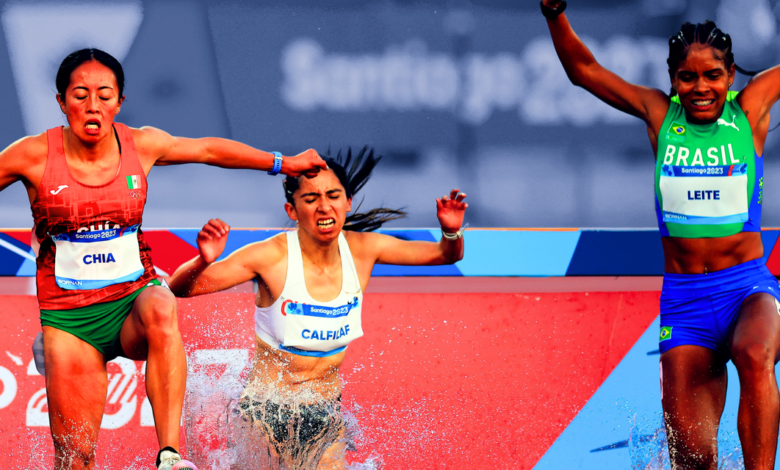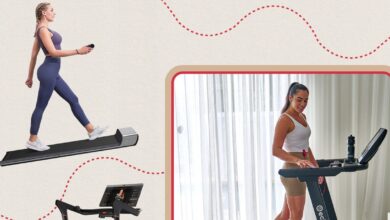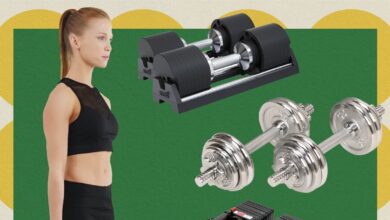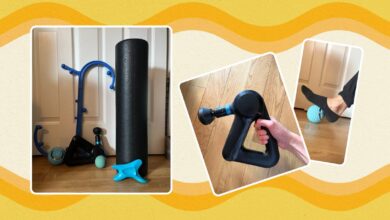What Exactly Is Steeplechase (and Why Is There…a Water Pit on the Track?!)

Runners continue for a total of seven and a half laps, clearing five evenly-spaced barriers with every loop.
Where TF did the water pit come from!?
Okay, the water pit is…odd. The track steeplechase, in all its puddled glory, likely originated from the horse event of the same name. In the first equine steeplechases, jockeys raced between towns in 18th-century Ireland, navigating a course using pointy church steeples as guides, as the Washington Post reported. Along the way, the horses crossed natural barriers, including fences, stone walls, streams, and rivers. (Sound familiar?)
Eventually, the event transformed from a horse race to a footrace, but still retained the drama of wet and dry obstacles. According to Brittanica, the human-powered steeplechase was first contested as a cross-country event in 1850 at the University of Oxford. The men’s steeple became an Olympic event in 1920, though the women’s race didn’t come to the Games until 88 years later.
So…do your feet get wet?
We’re sorry to have to answer the most pressing question in the affirmative: Yes, the runners’ feet get wet. But most steeplechase athletes go sock-free, and their racing shoes (called spikes) are so lightweight and skin-tight, the runners aren’t sloshing around with heavy, waterlogged trainers. So even though they’ll be running through water, it might not be quite as uncomfortable as it sounds.
How do you win at steeplechase?
Like every track event, the first to cross the finish line takes the win. But winning the steeplechase demands different skills than races that keep runners on solid ground. The water pit in particular requires more tactical finesse. Unlike sprint hurdles, runners surge when approaching the water jump, step on top of the barrier, and launch themselves over the water.
You need to go in with confidence: “The biggest thing is trying not to stutter, or take short baby steps, into and out of the hurdles,” Howard says, who explains that runners often have to jump toward a barrier even if someone is blocking their view. As for landing, one foot is better than two. “If you ‘double foot to land’ as we call it, you’re just losing a lot of momentum,” says Howard.
Because the jumps are so tactical and there’s plenty of room for error, the race can change dramatically coming out of a water jump, making it a particularly exciting event for spectators.
Who should we be watching for in Paris?
For one, Howard! The day after speaking with SELF, Howard punched her ticket to Paris at the Olympic Trials in Eugene, Oregon, finishing third behind Valerie Constien and Courtney Wayment. A Boise State graduate and former school nurse, Howard—who’s supported by running apparel brand Tracksmith but doesn’t have a traditional big-name sponsor (yet)—ran a career-best at the Trials, beating her personal record by 15 seconds to make her first Olympic team at 31.
Constien, who’s sponsored by Nike, also ran a personal best, breaking the meet record in 9:03.22 to become the steeplechase national champion. The 28-year-old Colorado native represented Team USA in the steeplechase at Tokyo, where she came in 12th, so she’s got some Olympic experience under her belt. Wayment, a 25-year-old On-sponsored athlete, also ran a personal best at the trials (finishing in 9:06.55); she brings to the Games a 2022 NCAA title in the steeplechase.
Ugandan steeplechaser Peruth Chemutai and Kenyan Beatrice Chepkoech won’t make it easy for Team USA, but we’ll be watching and cheering them on. Catch all the Olympic steeplechase action starting with a qualifying round on August 4 and the finals on August 6.
SELF is your one-click source for all things Summer Olympics. Read our latest coverage of the Paris Games here.
Related:
- The Sweet Reason Track Star Sha’Carri Richardson Does Her Nails
- How the World’s Best Athletes Are Using Glam to Express Themselves in Paris
- Track Star (and Musician!) Nia Akins on the Songs That Hype Her Up and Calm Her Down
Get more of SELF’s great sports coverage delivered right to your inbox—for free.



